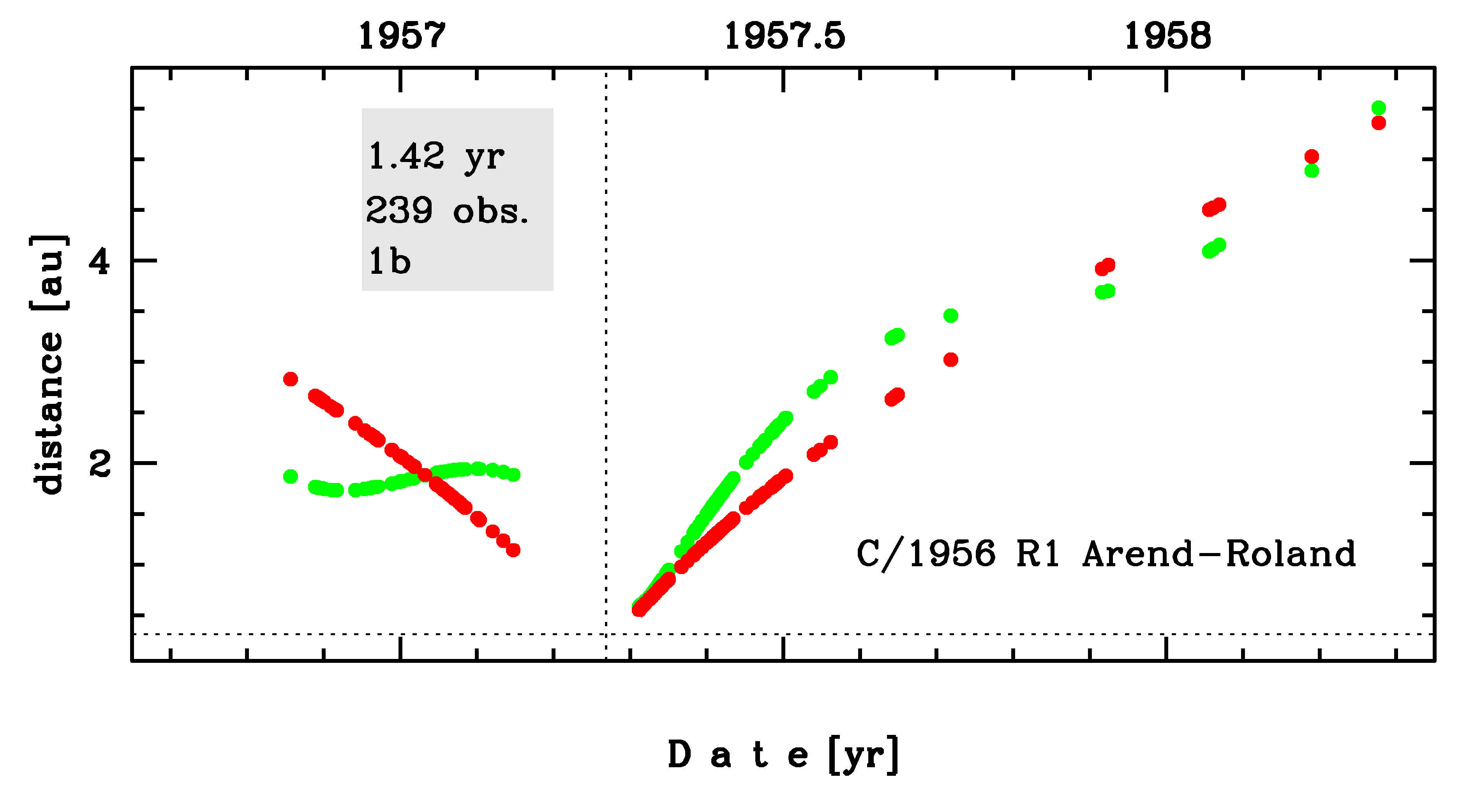C/1956 R1 Arend-Roland
more info
Comet C/1956 R1 was discovered on 8 November 1956 by Sylvain Julien Victor Arend and Georges Roland (Royal Observatory, Uccle, Belgium), that is 5 months before its perihelion passage. Later, Sigeru Kaho (Tokyo Observatory, Konko Station, Japan) found an image of this comet on a plate he had exposed on 7 November 1956 during observations of variable stars. C/1956 R1 was observed until 11 April 1958 [Kronk, Cometography: Volume 4].
Comet had its closest approach to the Earth on 20 April 1957 (0.569 au), 12 days after its perihelion passage.
This is a comet with nongravitational effects strongly manifested in positional data fitting. Two NG solutions given here are based on data spanning over 0.602 yr in a range of heliocentric distances: 1.16 au – 0.778 au (perihelion) – 2.86 au; asymmetric NG solution was chosen as preffered orbit.
All solutions given here are based on data spanning over 1.42 yr in a range of heliocentric distances: 2.83 au – 0.316 au (perihelion) – 5.36 au.
This Oort spike comet suffers rather notable planetary perturbations during its passage through the planetary system; these perturbations lead to escape the comet from the planetary zone on a hyperbolic orbit (see future barycentric orbits).
See also Królikowska 2014 and Królikowska 2020.
Comet had its closest approach to the Earth on 20 April 1957 (0.569 au), 12 days after its perihelion passage.
This is a comet with nongravitational effects strongly manifested in positional data fitting. Two NG solutions given here are based on data spanning over 0.602 yr in a range of heliocentric distances: 1.16 au – 0.778 au (perihelion) – 2.86 au; asymmetric NG solution was chosen as preffered orbit.
All solutions given here are based on data spanning over 1.42 yr in a range of heliocentric distances: 2.83 au – 0.316 au (perihelion) – 5.36 au.
This Oort spike comet suffers rather notable planetary perturbations during its passage through the planetary system; these perturbations lead to escape the comet from the planetary zone on a hyperbolic orbit (see future barycentric orbits).
See also Królikowska 2014 and Królikowska 2020.
| solution description | ||
|---|---|---|
| number of observations | 239 | |
| data interval | 1956 11 08 – 1958 04 11 | |
| data type | perihelion within the observation arc (FULL) | |
| data arc selection | entire data set (STD) | |
| range of heliocentric distances | 2.83 au – 0.32 au (perihelion) – 5.36 au | |
| type of model of motion | NT - non-gravitational orbits for asymmetric, standard g(r) | |
| data weighting | YES | |
| number of residuals | 458 | |
| RMS [arcseconds] | 1.38 | |
| orbit quality class | 1b | |
| next orbit statistics, both Galactic and stellar perturbations were taken into account | ||
|---|---|---|
| no. of returning VCs in the swarm | 0 | |
| no. of escaping VCs in the swarm | 5001 | |
| no. of hyperbolas among escaping VCs in the swarm | 5001 | * |
| next reciprocal semi-major axis [10-6 au-1] | -597.95 – -583.96 – -569.41 | |
| next perihelion distance [au] | 0.816 – 0.831 – 0.846 | |
| synchronous stop epoch [Myr] | 0.724 | S |
| percentage of VCs with qnext < 10 | 100 | |
| next_g orbit statistics, here only the Galactic tide has been included | ||
|---|---|---|
| no. of returning VCs in the swarm | 0 | |
| no. of escaping VCs in the swarm | 5001 | |
| no. of hyperbolas among escaping VCs in the swarm | 5001 | * |
| next reciprocal semi-major axis [10-6 au-1] | -598.02 – -584.02 – -569.47 | |
| next perihelion distance [au] | 0.863 – 0.88 – 0.896 | |
| synchronous stop epoch [Myr] | 0.736 | S |
| percentage of VCs with qnext < 10 | 100 | |
